| |
|
Ipswich is the county town
of Suffolk, and is also probably the longest
continuously occupied town in England. Here on
the River Gipping, in the south of the
Anglo-Saxon kingdom of East Anglia, a number of
7th Century industrial villages grew together,
and since then Ipswich has always been an
industrial and commercial town, processing the
produce of the land round about, and exporting it
down the River Orwell to other parts of England
and the continent. It was wealthy in the late
medieval period, but it suffered from being cut
off from its European markets by the outfall from
the Reformation. A strongly puritan town in the
17th Century, a quiet backwater in the 18th
Century, it was not until the Industrial
Revolution that it rose to commercial prominence
again, with heavy industry producing agricultural
machinery, vehicles and other ironwork. It would
continue to be important industrially until the
1980s, but then most of the factories closed, and
the town has not yet recovered. The townscape is punctuated by
church towers and spires, for Ipswich has twelve
surviving medieval churches. Remarkably, six of
them are still in use, and of these St Mary le
Tower is the biggest and most prominent. Its
spire rises sixty metres above the rooftops,
making it the second tallest building in the town
after the Mill apartment block on the Waterfront.
There was a church here in 1200, when the Borough
of Ipswich came into being in the churchyard by
the declaration of the granting of a charter. The
medieval church had a spire until it came down in
the hurricane of 1661. When the Diocese of
Norwich oversaw the restoration of the church in
the mid-19th Century the decision was taken for a
complete rebuild in stone on the same site. It is
almost entirely the work of diocesan surveyor
Richard Phipson, who worked on it over a period
of twenty years in the 1850s and 1860s, including
replacing the spire, and so this is East Anglia's
urban Victorian church par excellence.
The rebuilding was bankrolled by the wealthy
local Bacon banking family. It is a large church,
built more or less on the plan of its
predecessor, full of the spirit of its age. One
could no more imagine Ipswich without the Tower
than without the Orwell Bridge.
The length of the church
splits the churchyard into two quite separate
parts, the south side a public space, the walled
north side atmospheric and secretive. The large
cross to the south-west of the tower is not a war
memorial. It remembers John Patteson, Bishop of
Melanesia, murdered by some of his flock in the
1870s. Treated as a martyr by the press of the
day, Patteson appears to have had no local
connection, but the Pattesons had intermarried
with the Cobbolds, an important local family, and
Patteson Road by Ipswich docks also remembers
him. There never was a north door, and the west
doors are beautiful and liturgically correct but
perhaps not useful, since they are below street
level and the path merely leads round to the
south, allowing processions but no access from
Tower Street. The flushwork is exuberant, and
makes you think that being a flint-knapper must
have been a good living in the 1860s. As with the
medieval predecessor, the entrance is through the
tower which forms a porch on the south side, in
common with about thirty other East Anglian
churches. Until the rebuilding there was a
further castellated porch on the south side of
the tower, something in the style of the Hadleigh
Deanery tower, but this was removed. You can see
it in as photograph at the top of this page.
There is a small statue of
the church's patron saint in the niche above the
entrance, by the sculptor Richard Pfeiffer. Away
to the east, the same sculptor produced St John
the Evangelist and St Mary Magdalene on the end
of the chancel, and there is more of his work
inside. You step into the tower porch under
vaulting. A small door in the north-east corner
leads up into the ringing chamber and beyond that
the belfry, with a ring of twelve bells. The
south doorway into the church has stops
representing the Annunciation, with the angel to
the west, and Mary at her prayer desk to the
east. As part of a Millennium project this
doorway was painted and gilded. It leads through
into the south aisle, beyond which the wide nave
seems to swallow all sound, a powerful transition
from the outside. Polished wood and tile gleam
under coloured light from large windows filled
with 19th Century glass. At one time the walls
were stencilled, but this was removed in the
1960s. The former church was dark and serious
inside, as a drawing in the north aisle shows, so
it must have made quite a contrast when the
townspeople first entered their new church.
The font by the doorway is
the first of a number of significant survivals
from the old church. It's one of the 15th Century
East Anglian series of which there are more than
a hundred in existence, all slightly different.
It is in good condition, and ironically this may
be because Ipswich was a town which embraced
protestantism whole-heartedly after the
Reformation, and so it is likely that the font
was plastered over in the mid-16th Century to
make it plain and simple. The lions around the
pillar stand on human heads, and there are more
heads beneath the bowl. The next survival that
comes into view is the pair of 15th Century
benches at the west end of the nave. The bench
ends are clerics holding books, and above them
memorable finials depicting two lions, a dragon
and what might be a cat or a dog.
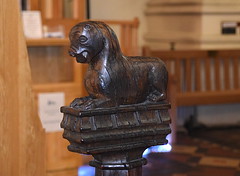   
 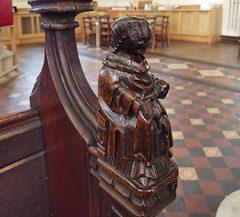 
The box pews
were removed as part of Phipson's restoration and
replaced with high quality benches. The front row
are the Borough Corporation seats, a mace rest
and a sword rest in front of them. The carvings
on the ends of the benches are seahorses, the
creatures that support the shield on the Ipswich
Borough arms, and on the finials in front are
lions holding ships, the crest of the Borough. As
you might expect in Ipswich these are by Henry
Ringham, whose church carving was always of a
high quality, and is perhaps best known at
Woolpit and Combs. His workshop on St John's Road
employed fifty people at the time of the 1861
census, but by the following year he was
bankrupt, and so the work here is likely some of
the last that he produced. He died in 1866, and
Ringham Road in east Ipswich remembers him.
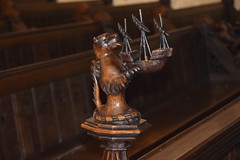 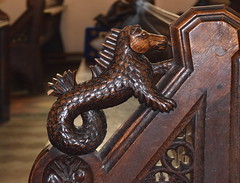 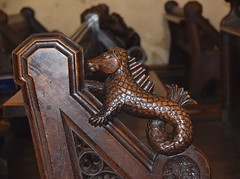 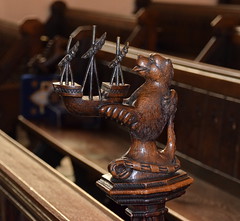
Moving into the chancel,
the other major survival is a collection of late
15th and early 16th Century brasses. Altogether
there are ten large figures, but in fact some of
them represent the same person more than once.
The most memorable is probably that of Alys
Baldry, who died in 1507. She lies between her
two husbands. The first, Robert Wimbill, is on
the right. He died in about 1477. He was a
notary, and his ink pot and pen case hang from
his belt. Her second husband, Thomas Baldry, is
on the left. He died in 1525. He was a merchant,
and his merchant mark is set beneath his feet
next to Alys's five daughters and four sons.
Alys Baldry, Robert Wimbill
and Thomas Baldry are all depicted in further
brasses here. The best of these is that to
Robert. It was commissioned by his will in the
1470s. He lies on his own with a Latin
inscription which translates as 'My hope lies in
my heart. Holy Trinity, one God, have mercy on
me.' His ink pot and pen case hang from his belt
again, and between his feet are a skull and
scattered bones, an early memento mori.
Thomas Baldry's own brass memorial shows him
lying between his two wives, Alys who we have
already met, and his second wife Christian. The
other group of three figures depicts Thomas
Drayll, a merchant, with his wives Margaret and
Agnes. Thomas died in 1512. The arms of the
Cinque Ports are set above him, and a large
merchant mark is beneath his feet. Several
inscriptions are missing, and we know that when
the iconoclast William Dowsing visited the church
on 29th Janary 1644 he ordered the removal of six
brass inscriptions with Ora pro nobis ('pray
for us') and Ora pro animabus ('pray for
our souls'), and Cujus animae propitietur
deus ('on whose soul may God have mercy')
and pray for the soul in English.
  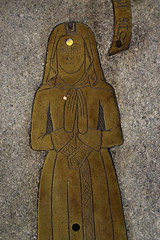 
  
 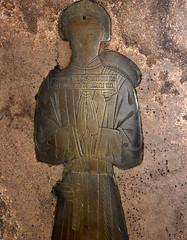  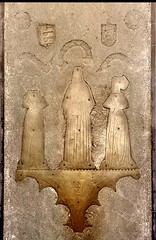
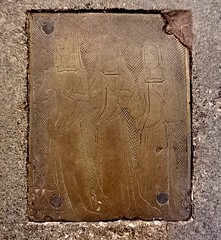 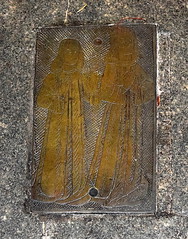 
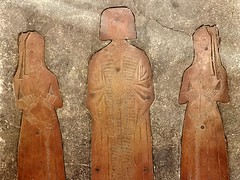 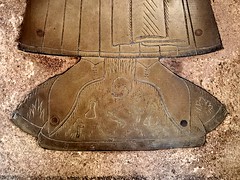

The spectacular sanctuary
with its imposing reredos, piscina and sedilia
was clearly designed for shadowy, incense-led
worship. A lush Arts and Crafts crucifixion
surmounts the altar. East Anglian saints flank
the walls. James Bettley, revising the Buildings
of England volume for East Suffolk, records
that it was the work of Somers, Clarke &
Micklethwaite in the 1880s. The chancel is only
lit from the east window, emphasising the focus
from the rest of the church. The set of twelve
apostles and twelve angels on the choir stalls
are also by Pfeiffer. You can see his signature
on the back of St Luke's icon of the Blessed
Virgin. This sanctuary is the ultimate expression
of late 19th Century Tractarianism in Suffolk.
Back in the nave, the early 18th Century pulpit
speaks of a different liturgical age, when this
church was a preaching house rather than a
sacramental space. James Bettley credits its
carving to James Hubbard, and notes its
similarity to that in the Unitarian Meeting House
a few hundred yards off. The 19th Century screen
that stood in the chancel arch and separated
these two liturgical ages was moved to the east
end of the north aisle as an organ screen some
time in the 20th Century.
Another screen separates
off the Lady Chapel from the south aisle and the
chancel. The chapel is a pleasing period piece,
furnished sentimentally. The reredos, by Arthur
Wallace in 1907, depicts the Supper at Emmaus
flanked by Moses and Elijah in an echo of the
Transfiguration. The early 20th Century paintings
on the south wall are lovely, especially the
infant Christ as he plays at the feet of St
Joseph. But the overwhelming atmosphere of this
church comes from its extensive range of 19th
Century glass, the largest collection in Suffolk.
It provides a catalogue of some of the major 19th
Century workshops over a fairly short period,
from the 1850s to the 1880s. Much of it is by
Clayton & Bell, who probably received the
commission for east and west windows and south
aisle as part of Phipson's rebuilding contract.
Other major workshops include those of William
Wailes, the O'Connors and Lavers, Barraud &
Westlake. A small amount of 1840s glass in the
north aisle was reset here from the previous
church. There are photographs of the glass at the
bottom of this page.
As was common in major 19th
Century restorations, the memorials that once
flanked the walls were collected together and
reset at the west end of the nave. At St Mary le
Tower this was a major task, for there are a lot
of them. The most famous is that to William
Smart, MP for Ipswich in the late 16th Century.
It is painted on boards. His inscription is a
long acrostic, and he kneels at the bottom
opposite his wife. between them is a panoramic
view of the Ipswich townscape as it was in 1599,
the year that he died, a remarkable snapshot of
the past. Other memorials include those of the
17th Century when Ipswich was the heartland of
firebrand protestant East Anglia. Matthew
Lawrence, who died in 1653, was the publike
preacher of this towne. There are more
memorials in the north chancel aisle, now divided
up as vestries. The best of these is to John and
Elizabeth Robinson. He died in 1666. They kneel
at their prayer desks, and below them are their
children Thomas, John, Mary and Elizabeth, who
all predeceased their mother. Also here are
memorials to a number of the Cobbold family, who
were not only important locally but even provided
ministers for this church.
  
   
 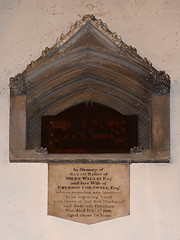 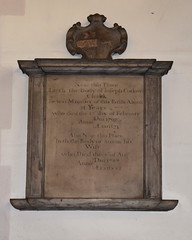
 
 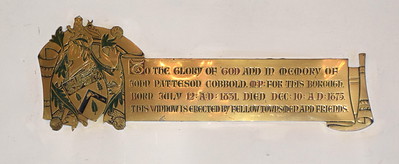
There are more Cobbold
memorials in the nave, including one in glass at
the west end of the north aisle. It is dedicated
to Lucy Chevallier Cobbold, and depicts her with
her daughter at the Presentation in the Temple.
The Cobbold family embraced Tractarianism
wholeheartedly, being largely responsible for the
building of St Bartholomew near their home at
Holywells Park. They probably had an influence
over the Bacon family, whose wealth went towards
the rebuilding, and whose symbol of a boar can be
seen in the floor tiles. A good set of Stuart
royal arms hangs above the west doorway.
I can't
imagine what the 17th Century parishioners would
make of this church if they could come back and
see it now. Trevor Cooper, in his edition of The
Journals of William Dowsing, recalls that
the atmosphere in the town was so strongly
puritan that in the 1630s the churchwardens were
excommunicated for refusing to carry out the
sacramentalist reforms of Archbishop Laud. The
reforms demanded that the altar be returned to
the chancel and railed in, but this was
considered idolatrous by the parishioners. When
the visitation commissioners of the Bishop of
Norwich came to the church in April 1636 to see
if the commands had been carried out, the
churchwardens refused to give up the keys...
verbally assaulting them and and confronting them
with 'musketts charged, swords, staves and other
weapons'.
Frank Grace,
in his 'Schismaticall and Factious Humours':
Opposition in Ipswich to Laudian Church
Government, records a number of other
incidents both here and in other Ipswich churches
in the late 1630s, including an attack on 'a
conformable minister' (that is to say one
faithful to the Bishop) by a mob as well as a
stranger who was invited by the town bailiffs to
preach a very factious and seditious sermon
in Tower church to a large congregation
against the authority of the incumbent, who no
doubt was held at bay while the ranting went on.
As with all the Ipswich churches, the iconoclast
William Dowsing was welcomed with open arms by
the churchwardens here on his visit of January
1644. Looking around at Phipson's sacramental
glory, it is hard to imagine now.
In January
2025, St Mary le Tower was elevated to the status
of a Minster church.
|
|
|

